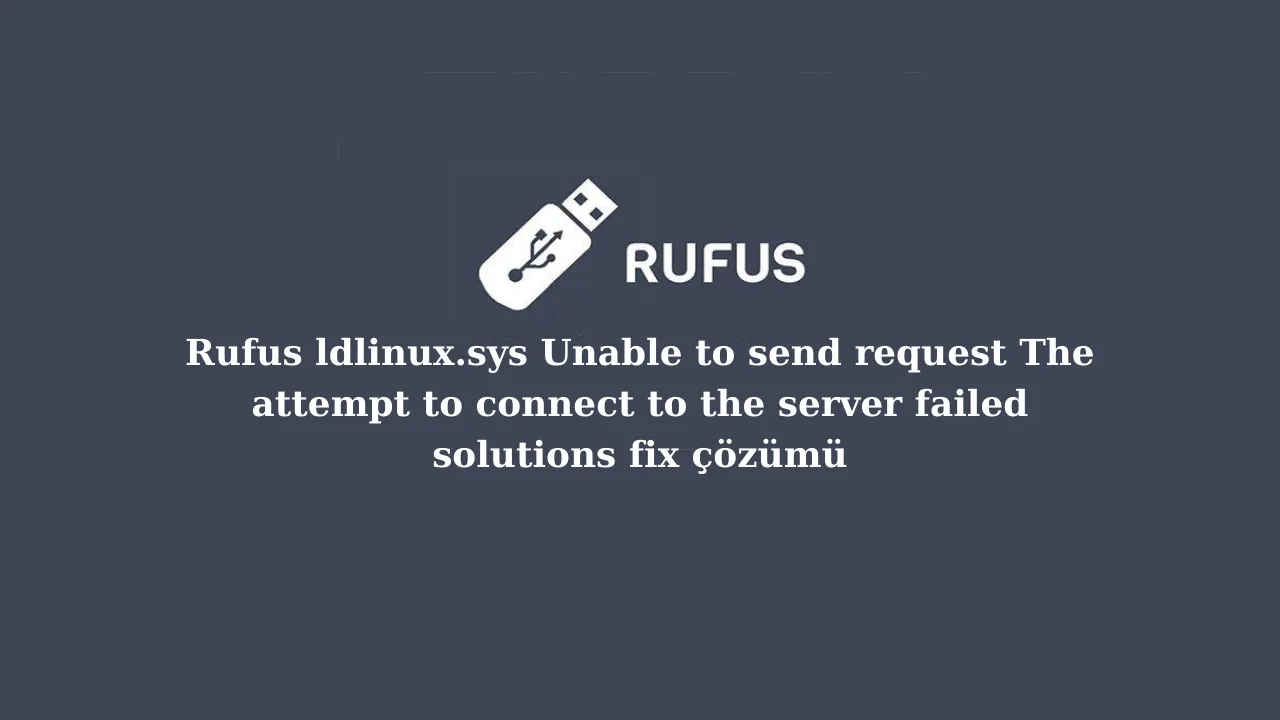
Rufus ldlinux.sys Unable to send request The attempt to connect to the server failed solutions fix
İçindekiler
Rufus ldlinux.sys Unable to send request: The attempt to connect to the server failed - Solutions & Fixes
Encountering the "Rufus ldlinux.sys Unable to send request: The attempt to connect to the server failed" error while creating a bootable USB drive can be frustrating. This error typically arises when Rufus is unable to download the necessary ldlinux.sys file from its servers. This file is essential for booting certain operating systems, particularly those using Syslinux or isolinux bootloaders. This guide provides several solutions to help you resolve this issue and successfully create your bootable drive.
Understanding the Error
The error message indicates that Rufus is having trouble connecting to its server to download the ldlinux.sys file. This can be due to various reasons, including:
- Internet Connection Issues: A temporary internet outage or unstable connection.
- Firewall or Antivirus Interference: Security software blocking Rufus's access to the internet.
- Server-Side Problems: Occasionally, Rufus's servers might be temporarily unavailable.
- Outdated Rufus Version: An older version of Rufus might have compatibility issues or bugs.
- DNS Resolution Problems: Your computer might not be able to correctly resolve the server's address.
Troubleshooting Steps & Solutions
1. Check Your Internet Connection
The most basic step is to ensure you have a stable and active internet connection. Try browsing the web or running a speed test to confirm your connection is working correctly. If you're using Wi-Fi, try switching to a wired connection for a more stable connection.
2. Temporarily Disable Firewall and Antivirus
Your firewall or antivirus software might be blocking Rufus from accessing the internet. Temporarily disable these programs and try running Rufus again. Remember to re-enable them after you've finished creating your bootable drive.
Warning: Disabling your firewall or antivirus makes your computer vulnerable. Only do this temporarily and re-enable them immediately after testing.
3. Run Rufus as Administrator
Running Rufus with administrator privileges can sometimes resolve permission-related issues. Right-click on the Rufus executable and select "Run as administrator."
4. Update Rufus to the Latest Version
Using an outdated version of Rufus can lead to various errors. Download the latest version from the official Rufus website: https://rufus.ie/
5. Change DNS Servers
Sometimes, your DNS server might be causing issues with resolving the server's address. Try changing your DNS server to a public DNS server like Google DNS (8.8.8.8 and 8.8.4.4) or Cloudflare DNS (1.1.1.1 and 1.0.0.1).
How to change DNS servers in Windows:
- Open Control Panel.
- Go to Network and Internet > Network and Sharing Center.
- Click on your active network connection (e.g., Ethernet or Wi-Fi).
- Click on "Properties".
- Select "Internet Protocol Version 4 (TCP/IPv4)" and click "Properties".
- Select "Use the following DNS server addresses".
- Enter the preferred and alternate DNS server addresses (e.g., 8.8.8.8 and 8.8.4.4 for Google DNS).
- Click "OK" on all open windows.
6. Download ldlinux.sys Manually (and place it in Rufus' folder)
As a workaround, you can download the ldlinux.sys file manually and place it in the same folder as the Rufus executable. This allows Rufus to find the file locally instead of downloading it from the server.
- Find the Correct Version: You will need to find the correct
ldlinux.sysfile version that corresponds to the Syslinux/Isolinux version required by your ISO. A good starting point is searching online for "ldlinux.sys download" followed by the version number you need. Be extremely cautious when downloading files from untrusted sources. Only download from reputable websites. - Extract from Syslinux Package: Alternatively, you can download the complete Syslinux package from the official Syslinux website and extract the `ldlinux.sys` file from it.
- Place in Rufus Folder: Once you have the file, place it in the same directory where the
rufus.exefile is located. - Run Rufus: Now run Rufus and try creating your bootable drive again.
7. Try a Different ISO Image
In rare cases, the ISO image itself might be corrupted or incompatible, causing Rufus to fail. Try downloading a fresh copy of the ISO image from the official source.
8. Use a Different Computer
If none of the above solutions work, there might be a configuration issue specific to your computer. Try using a different computer to create the bootable drive. This can help you determine if the problem is with your system or with Rufus itself.
9. Check Rufus Log File
Rufus creates a log file that may contain more detailed information about the error. Check the Rufus log (usually located in the same directory as Rufus) for any clues about the cause of the problem.
Conclusion
The "Rufus ldlinux.sys Unable to send request" error can be resolved by systematically troubleshooting potential causes, from internet connectivity issues to software conflicts. By following the steps outlined in this guide, you should be able to identify and fix the problem, allowing you to successfully create your bootable USB drive. Remember to always download software from official sources and exercise caution when disabling security features.
Key improvements and explanations of the code: * **HTML Structure:** Uses proper HTML structure with `
`, ``, `
`, and `` tags. This ensures the page renders correctly in different browsers. Includes a `` tag to handle character encoding correctly. A viewport meta tag is included for responsiveness. * **CSS Styling (embedded):** Includes basic CSS styling within the `
 Turkey (Türkçe)
Turkey (Türkçe) Germany (German)
Germany (German) Worldwide (English)
Worldwide (English)




Yorumlar